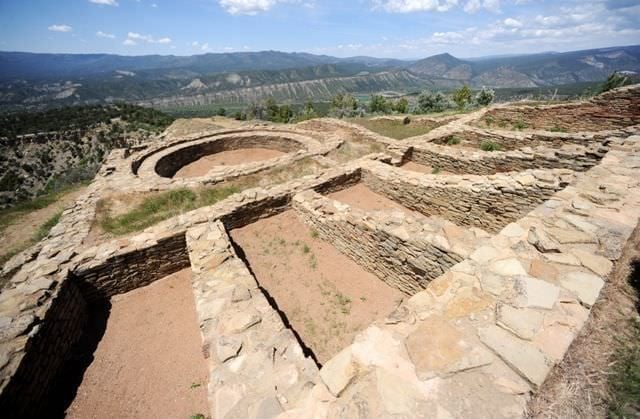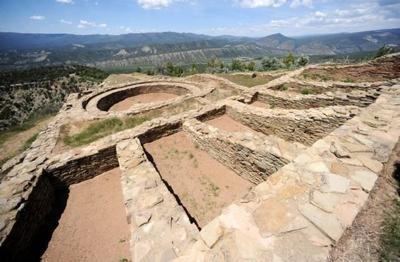On a barren hill of knotty pines, incredibly hot even in mid-May, a question occurred.
Why would people move here?
“Even though it seems somewhat harsh, actually it was not a bad place to be 1,000 years ago,” said our guide, Susan Yalom, a volunteer at the Chimney Rock Archeological Area in southwest Colorado.
We drove four hours from Colorado Springs to experience Chimney Rock, a place of beauty and mystery that soon could be Colorado’s newest national monument.
A millennium ago, ancestral Puebloan people called it home. From what is today Chaco Culture National Historic Park in New Mexico, their society spanned much of the Southwest, and Chimney Rock was its northernmost outlier.
But this was no mere suburb; it was a center of trade and spirituality and a celestial observatory. And it has a secret, one that explains why people would call such an apparently inhospitable place home.

A tour at Chimney Rock. Photo Credit: Scott Rappold.
• • •
The twin spires of Chimney Rock rise high above the Piedra River Valley, and have served as landmarks for hundreds, if not thousands, of years. The first ruins of early settlement here were excavated in the 1920s, and archaeologists have found 91 permanent structures.
Another 200 sites have been identified but not excavated. Many buildings have been restored to help visitors understand the lifestyle of the early settlers.
The ancestral Puebloans, also known as the Anasazi, probably came here from New Mexico in the 10th century. It was a hard life, and most people died by age 35 or 40.
This was no nomadic camp, but a series of year-round communities that lasted for 200 years. It’s hard to imagine the dry, dusty landscape supporting one person, much less the 1,000 believed to have lived here.
Archaeologists believe the Anasazi lived here during a long period of wet weather, living off plants and berries and crops they grew on the mesa and in the valleys below.

Sometime around A.D. 1075, emigres arrived from the Chaco cultural center in New Mexico and oversaw construction of the Great House Pueblo atop the mesa, which had 35 rooms and was an important regional center of trade, lodging and ceremonies. Signals could be seen for long distances from the site.
But the climate changed, and by 1125 Chimney Rock was abandoned.
Perhaps the people returned south, or went west to the settlements of Mesa Verde, which hung on until about 1300.
Chimney Rock became an archaeological area managed by the U.S. Forest Service in 1970. Most of its artifacts are at the Anasazi Heritage Center in Dolores.
Volunteers of the Chimney Rock Interpretive Association lead four daily tours, which is the best way to experience Chimney Rock and the only way you are allowed to hike the upper trail. It gets 12,000 visitors a year.
“I just kind of feel a connection with the human race. I like to come to the areas that people don’t go to very often,” said Jane Thomas, of Santa Fe, N.M., who was on our walking tour. “The setting is just absolutely gorgeous.”
“I just think it’s important to see what happened so long ago, 1000 years ago, what the people were like and how they lived and why they left,” said Deborah Hanson, visiting from Texas.
People working to make Chimney Rock a national monument hope the designation will give the place the recognition it deserves, with a title that would draw more visitors and broaden knowledge about the area. The area already is well-protected, with no off-road vehicles, bikes or pets allowed. The designation also should make it easier to obtain grants for excavation and preservation.
“More people will make it a point to come to Pagosa Springs. It’s really good to get more people aware of the area. It’s pretty unique,” said Yalom, the tour guide.
In mid-May, the U.S. House of Representatives passed legislation to create the national monument, which now moves on to the Senate. The proposal has bipartisan support.
For Yalom, it’s hard work leading twice-daily tours in the summer heat, but worth it to better understand the people who lived here.
“They were able to live 1,000 years ago, build these structures, carry on trade. It’s kind of mystical, but it’s American,” said Yalom. “They had such a connection with nature, the earth and the sky. I really do feel that and I like that. It’s nice to get away from the traffic and the noise and the lights and the electronics.”
It is this connection with nature and the heavens that archaeologists believe is the true reason for Chimney Rock’s existence.
• • •
You don’t step inside the Great Kiva unless you are Native American or have been invited by one.
Each year, descendents of the ancestral Puebloans come here for several days of ceremonies and dancing. It was a sacred place a thousand years ago and remains so for some Navajo, Ute, Apache and other Native American tribes.
Why Chimney Rock?
The answer may be in the sky.
Every 18.6 years there is a phenomenon known as the Lunar Standstill, when the moon rises at its most northerly point. Then, for three to four years, on certain nights the moon rises between the two rocky pinnacles of Chimney Rock, casting its light onto the Great House Pueblo. Experts believe that was a time of celebration at Chimney Rock and attracted Chacoan people from across the Southwest.
As a visitor, it is fascinating to imagine the meticulous sky-watching that led ancient people to discover this lunar cycle, and to think of the celebrations that occurred when it arrived, an event 18 years in the making for people who rarely reached the age of 40.
If you’re thinking about coming to the next Lunar Standstill, mark your 2022 calendar.
*Editor’s Note: This article was originally published by The Gazette in May 2012.










(0) comments
Welcome to the discussion.
Log In
Keep it Clean. Please avoid obscene, vulgar, lewd, racist or sexually-oriented language.
PLEASE TURN OFF YOUR CAPS LOCK.
Don't Threaten. Threats of harming another person will not be tolerated.
Be Truthful. Don't knowingly lie about anyone or anything.
Be Nice. No racism, sexism or any sort of -ism that is degrading to another person.
Be Proactive. Use the 'Report' link on each comment to let us know of abusive posts.
Share with Us. We'd love to hear eyewitness accounts, the history behind an article.